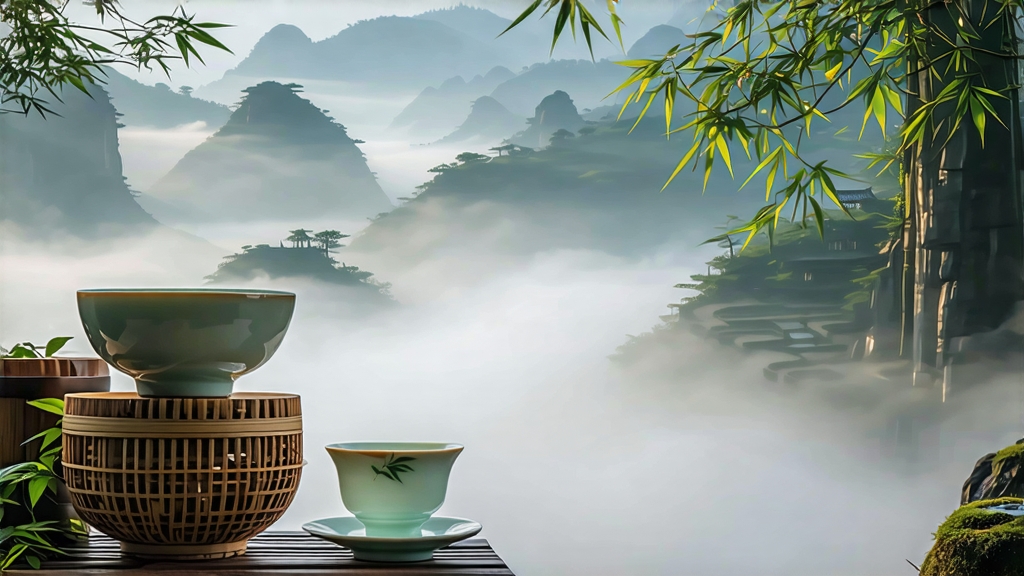
If green tea is the fresh-faced scholar of Chinese tea and pu-erh the bearded sage, then yellow tea is the quiet prince who vanished from court yet still carries imperial blood in his veins. Among the sparse yellow tea family, Meng Ding Huang Ya—literally “Yellow Bud from Meng Ding Peak”—is the rarest surviving scion of a tribute tradition that began 1,200 years ago on the mist-capped ridges of Ya’an, Sichuan. International drinkers often confuse it with a mellow green tea, but one sip of the liquor’s silk-gold shimmer and the softly expanding aroma of wet bamboo and steamed chestnut reveals a category of its own. This article invites you to travel beyond the label “yellow tea” and meet the mountain, the leaf, the craft, and the quiet ceremony that keep Meng Ding Huang Ya alive.
-
Historical scrolls in mountain mist
Meng Ding Mountain, a Taoist sanctuary since the Han dynasty, rises 1,450 m above the western rim of the Sichuan basin. Clouds arriving from the Min River gorge collide with cold plateau air, creating a 280-day-a-year fog curtain that filters light and slows photosynthesis—nature’s own shade-cloth for tender tea buds. The first written record of tea planting here appears in the Chronicle of Zhou during the Tang dynasty (A.D. 816), but the fame of Meng Ding Huang Ya exploded when Emperor Wen Zong (827–840) listed it among the thirteen “tributes of the realm.” Each spring, compressed cakes of the tea, wrapped in silk and sealed with camphor wood, traveled 1,800 km by horse and canal to Chang’an, arriving while the petals of the palace peonies were still damp. Song dynasty poet Lu You once sighed, “Meng Ding is the foremost tea under heaven; a single cup makes me abandon the wine cup forever.” After the Ming court abolished compressed tribute tea in 1391, the technique survived only in scattered nunneries on the mountain, passed mouth-to-ear like a secret sutra. When the Qing emperors shifted their taste to fragrant green teas, Meng Ding Huang Ya slipped into near extinction; by 1958 only three old craftsmen could still perform the sealed yellowing step. A state-led revival in the 1970s rescued the cultivar, yet even today less than 1,200 kg of authentic Meng Ding Huang Ya reach the market annually—rarer than many single-estate Darjeelings. -
The cultivar and its microterroir
The traditional garden sits on a knife-edge ridge called Shangqing Peak, where the soil is a crumbly quartz-rich phyllite weathered from ancient seabed. The local micro-cultivar, Camellia sinensis var. sinensis ‘Meng Ding #9’, develops unusually small buds—only 12–15 mm at harvest—yet each bud can contain up to 6.8 % theanine, almost double that of Longjing #43. Night temperatures frequently drop to 8 °C even in April, forcing the plant to store amino acids instead of converting them to catechins, hence the famous “sweet aftertaste without sugar.” Because the mountain is a protected scenic zone, no agro-chemicals are permitted; instead, farmers plant purple-flowering vetiver grass between rows to attract predatory insects and release fermented rapeseed cake as spring fertilizer. The harvest window opens for barely ten days around Qingming (early April) when the bud is still closed like a grain of rice and the first apical leaf is 60 % the length of the bud—standards stricter than those for Silver Needle white tea. -
Crafting the golden transformation
Yellow tea’s defining step is “sealed yellowing” (men huang), a slow enzymatic oxidation that occurs without the rolling trauma used for oolong or the microbial ripening of dark tea. Meng Ding Huang Ya undergoes three separate yellowing phases, each at diminishing temperature and humidity, stretching across four full days.
Phase 1 – Kill-green with retained heat
Leaves are hand-tossed in a bamboo-roaster at 140 °C for 90 seconds, just enough to deactivate leaf-edge oxidases while keeping the core enzymes alive. The roaster is fueled by 3-year-old bamboo culms; the escaping steam carries a faint scent of toasted young rice.
Phase 2 – Initial wrapping
The still-warm leaves are immediately piled in 250 g parcels using untreated mulberry